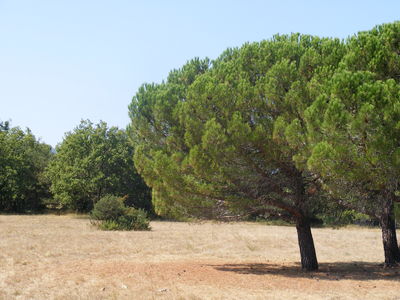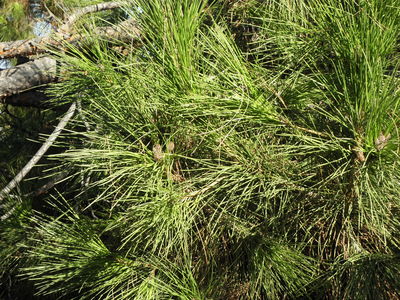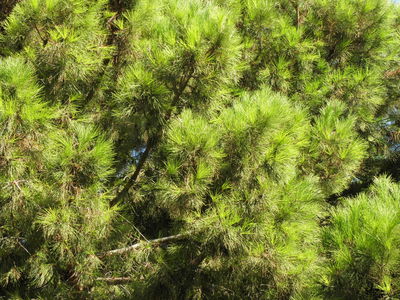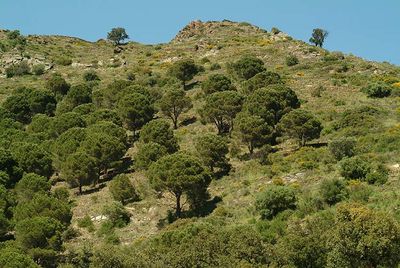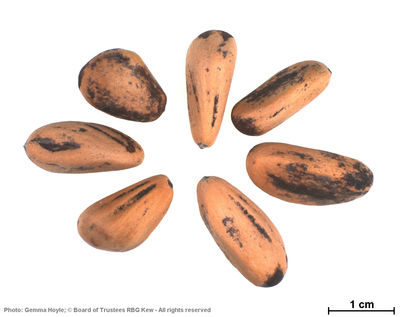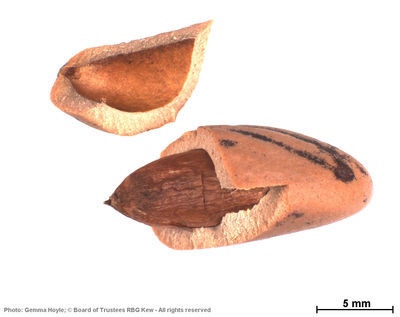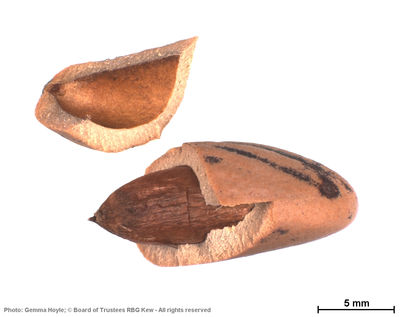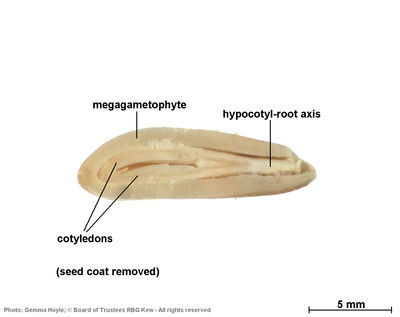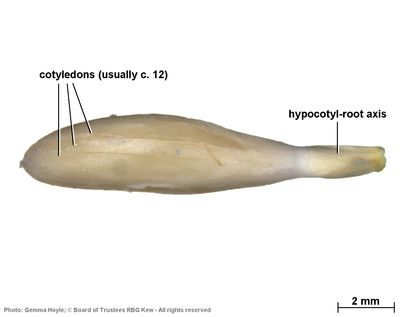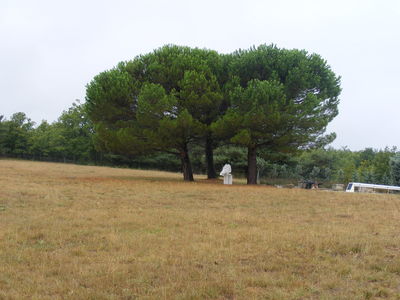Geography and distribution
Pinus pinea is native to coastal areas of Mediterranean Europe (Portugal, Spain, France, Italy, Albania, and Greece) and the Near East (Turkey, Cyprus, and Lebanon). It is found on coastal dunes and flats, and also on the lower slopes of hills and mountains up to 600 m above sea level. It is usually an emergent tree above shrubs (in maquis scrubland) or in low, open forests, but it can also occur with P. halepensis and in Quercus ilex maquis-woodland.
Description
With its tall, slim trunk and radiating spray of branches at the top, it is easy to see how the stone pine has also come to be known as the umbrella pine. It usually grows up to 20-25 m tall, either with a single trunk up to 1 m in diameter, or a trunk that forks into multiple stems not too far above the ground.
The bark is orange-brown to reddish-brown with grey patches and is thick and scaly, breaking into large, hard plates divided by deep irregular fissures.
The leaves (needles) have minutely toothed margins and are borne in groups of two, held by a basal sheath. The leaves are covered with a dull greyish, waxy coating when young, but become dark green and glossy when mature. The pollen cones are yellow and are short and cylindrical in shape.
The seed cones are borne singly, or sometimes in groups of two or three on short stems, and persist for several years, ripening in the third year. They are 9-13 cm long and up to 13 cm wide. The egg-shaped seeds are brown, 15-20 mm long and 8-10 mm wide, with a rudimentary wing.
The familiar fresh pine fragrance given off by the tree is due to oil released from the leaves. It is thought that the oil may help reduce the amount of water lost from the leaves.
Threats and conservation
Stone pine has been rated by IUCN as of Least Concern (LC). In South Africa, it has become naturalised and is an invasive species in the fynbos biome of the Cape.
Conservation assessments carried out by Kew
Pinus pinea is being monitored as part of the IUCN Sampled Red List Index for Plants, which aims to produce conservation assessments for a representative sample of the world's plant species. This information will then be used to monitor trends in extinction risk and help focus conservation efforts where they are needed most.
Uses
The edible seeds of the stone pine, popularly known as 'pine nuts', have been enjoyed for thousands of years, and were considered a delicacy by Roman soldiers. Millions of kilograms of 'pine nuts' are harvested each year in the Mediterranean. Whilst still closed, the cones are collected with hooked poles and then heated to release the seeds. The cones take a full three years to mature, making the production of 'pine nuts' a lengthy process - but one worth waiting for. When the seeds are harvested they are kept in their cones to ensure they are fresh when the time comes for eating or roasting them.
They are widely used in French and Italian dishes, and are an essential component of pesto, which also contains basil, parmesan, pecorino cheese, garlic, salt, and olive oil. Pine nuts are also used to make baklava, a very sweet pastry dessert popular in Middle Eastern cuisine.
The empty pine cones are used as decorative items in flower arrangements, and also serve as good hot-burning fuel for bakeries. The timber is of poor quality being coarse and resinous, but is used locally in furniture-making. The resin is tapped and used for varnishes, waterproofing, and as a source of rosin for waxing violin bows and ballet shoes. A green dye is made from the needles.
Stone pine is also valued as an ornamental across the parts of Europe with mild winters.
Millennium Seed Bank: Seed storage
Kew's Millennium Seed Bank Partnership aims to save plant life world wide, focusing on plants under threat and those of most use in the future. Seeds are dried, packaged and stored at a sub-zero temperature in our seed bank vault.
Description of seeds: Average 1,000 seed weight = 718 g
Number of seed collections stored in the Millennium Seed Bank: One
Seed storage behaviour: Orthodox (the seeds of this plant survive drying without significant reduction in their viability, and are therefore amenable to long-term frozen storage such as at the MSB)
Composition values: Average oil content = 47.7%. Average protein content = 34%.
Cultivation
The preferred method for propagating Pinus pinea is by seed, although it can also be propagated by taking cuttings or by grafting. It grows best in sandy loam to loam soil, with a pH of 5.5 to 6.5, and should be placed in full sunlight. Its drought tolerance is high, but it can suffer from damage caused by the fungus Diplodia pinea , which causes new shoots to become brown and stunted, and the fungus Mycosphaerella pini (red band needle blight), which causes red bands and spots on needles, and premature defoliation.
The stone pine has been cultivated at Kew since 1846, and 46 specimens are now held in the Living Collections across Kew and Wakehurst, where they are cared for by the Arboretum team. It is not generally warm enough in Britain for ripe seeds to form, so unfortunately we are not able to harvest and enjoy edible 'pine nuts'!
The stone pine at Kew
Kew's oldest stone pine can be seen growing close to the Director's Garden and the Secluded Garden. This specimen was planted in 1846 and was kept in a pot in Princess Augusta's nursery for many years, alongside other recently introduced pines, there being no space left for planting in the original five-acre arboretum. The tree became stunted and bonsai-like and, once planted out in the new 45 acres added to the arboretum, it eventually grew to form the unusual shape it displays today. After the tree lost a limb during a snowstorm in January 1926, it began to lean, and it is now supported by a prop. Despite this, it has grown to a height of 14 m, and is still in good health. A more recently planted stone pine can be seen in the Mediterranean Garden.
The Economic Botany Collection contains 24 specimens of Pinus pinea , including cones, roots, seeds, wood and 'strung kernels'.

_fullsize.jpg)



